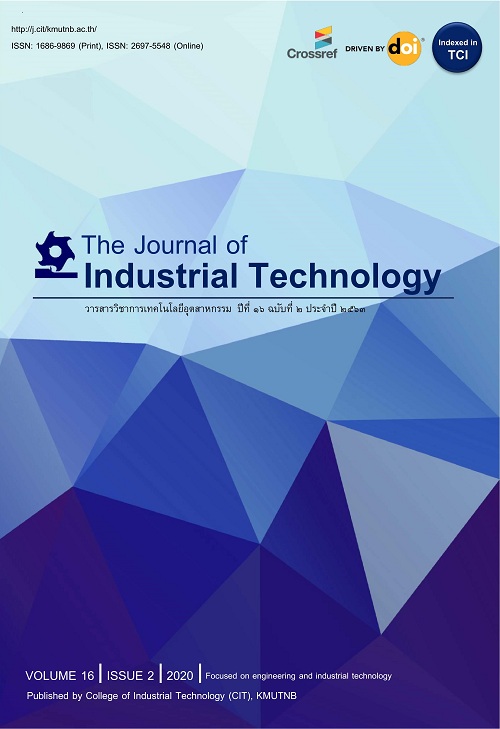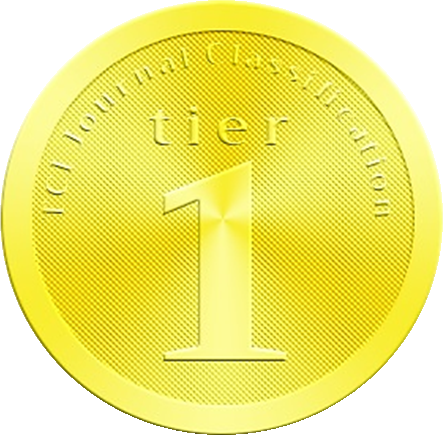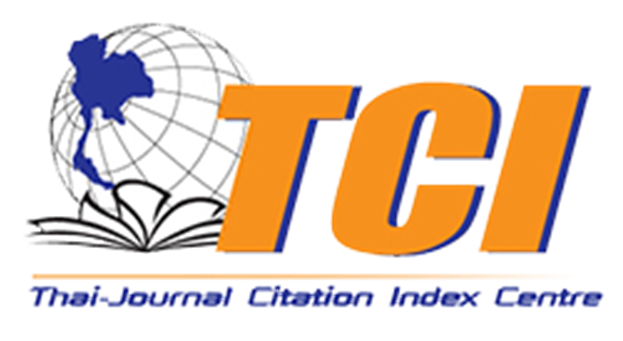A Design and Implement Series Stack Modules of DC-DC High Step-Up Converter for Front-End of Photovoltaic Cells Application
Abstract
งานวิจัยฉบับนี้ขอเสนอการออกแบบและสร้างต้นแบบของวงจรแปลงผันไฟฟ้ากระแสตรงแบบทบระดับแรงดันโดยการอนุกรมโมดูลด้านออกที่มีการควบคุมแบบลูปปิด เพื่อยกระดับแรงดันไฟฟ้ากระแสตรงที่มีค่าต่ำให้แปลงเป็นแรงดันไฟฟ้ากระแสตรงที่มีค่าสูง ได้มีการพัฒนาวงจรทบระดับแรงดันแบบดั้งเดิมโดยที่มีข้อจำกัดอัตราขยายที่ต่ำ ซึ่งถูกพัฒนาโดยใช้เทคนิคการเชื่อมโยงการเหนี่ยวนำ (Coupling Inductance) ในการเพิ่มขดลวด (L2) มาเชื่อมโยงกับขดลวดเหนี่ยวนำเดิม (L1) เทคนิคดังกล่าวสามารถเพิ่มอัตราขยายด้านออกให้สูงขึ้นผ่านตัวดำเนินการ a กำหนดให้โมดูลภาคกำลังทำงานภายใต้ความถี่สวิตช์ 90 กิโลเฮิรตซ์ ภาคกำลังแต่ละโมดูลได้รับแรงดันด้านเข้าขนาด 36 โวลต์ แปลงผันเป็นแรงดันไฟฟ้ากระแสตรงด้านออกขนาด 200 โวลต์ ในส่วนของวงจรภาคกำลังมีลักษณะการต่อแบบอนุกรม 3 โมดูล ผลการทดลองที่ได้จะมีระดับแรงดันเพิ่มขึ้นตามจำนวน N โมดูลที่นำมาต่อแบบอนุกรมสแตก เป็นผลทำให้แรงดันไฟฟ้ากระแสตรงถูกยกระดับขึ้นเป็น 600 โวลต์ ที่มีกำลังไฟฟ้าด้านออก 450 วัตต์ ที่โหลดเต็มพิกัด ด้วยเทคนิคการควบคุมแบบลูปปิดที่นำเสนอ จะเห็นได้ว่าเมื่อมีการเปลี่ยนแปลงภาระทางไฟฟ้าภายใต้เงื่อนไข สภาวะไร้โหลด สภาวะครึ่งโหลด และสภาวะเต็มโหลด ส่งผลให้แรงดันไฟฟ้ากระแสตรงด้านออกสามารถกลับเข้าสู่แรงดันไฟฟ้าตั้งค่า ทั้งนี้พบว่าผลที่ได้จากการจำลองและผลการทดลองมีความสอดคล้องกัน และสามารถยืนยันลำดับการวิเคราะห์ได้ตามทฤษฎี
This study presents the development and model of a DC voltage conversion circuit using series output modules with closed-loop control. To transform a low DC voltage into a high DC voltage. A voltage level transmitter circuit with limited gain has been created using traditional methods. The development included the use of the coupling Inductance technology, which entailed the addition of a coil L2 to be linked with the original inductance coil L1. This approach may enhance the output amplification by using operator the power modules are operated at a frequency of 90 kHz using a device that switches. Every power module is supplied with an input voltage of 36 volts and convert it into a voltage of 200 volts. A connection has been established in the power circuit. When connecting N modules in a series stack, the implement results will show an increase in voltage level. Consequently, the voltage is increased to 600 volts, generating an output power of 450 watts while operating at its full capacity. Using the proposed closed-loop control approach It is apparent that a change in electrical load occurs while changing from a no-load situation to a half-load one. at maximum load conditions. Consequently, the DC voltage output may revert again to the set value. The simulation findings and experimental results were found to be compatible. The analytical sequence may be verified based on theoretical principles.
Keywords
[1] B. Long, M. Zhang, Y. Liao, L. Huang and K.T. Chong, An overview of DC component generation, detection and suppression for grid-connected converter systems, IEEE Access, 2019, 7, 110426-110438.
[2] M. Forouzesh, Y.P. Siwakoti, S.A. Gorji, F. Blaabjerg and B. Lehman, Step-up DC–DC converters: A comprehensive review of voltage-boosting techniques, topologies, and applications, IEEE Transactions on Power Electronics, 2017, 32(12), 9143-9178.
[3] L. Qin, T. Qian, J. L. Soon, W. Hassan, Y. Liu and J. Mao, Interleaved split-switched-capacitor boost converter with continuous output current for electric vehicle standalone photovoltaic charging systems, IEEE Transactions on Power Electronics, 2023, 38(12), 16165-16179.
[4] S. -W. Seo, J. -H. Ryu, H.H. Choi and J.-B. Lee, Input-parallel output-series high step-up DC/DC converter with coupled inductor and switched capacitor, IEEE Access, 2023, 11, 89164-89179.
[5] R.R. Khorasani, H.M. Jazi, N.R. Chaudhuri, A. Khoshkbar-Sadigh, M. Shaneh and E. Adib, An interleaved soft switched high step-Up boost converter with high power density for renewable energy applications, IEEE Transactions on Power Electronics, 2022, 37(11), 13782-13798.
[6] S. Hasanpour and T. Nouri, New coupled-inductor high-gain DC/DC converter with bipolar outputs, IEEE Transactions on Industrial Electronics, 2024, 71(3), 2601-2613.
[7] S.-W. Lee and H.-L. Do, High step-up coupled-Inductor cascade boost DC–DC converter with lossless passive snubber, IEEE Transactions on Industrial Electronics, 2018, 65(10), 7753-7761.
[8] H. Liu and F. Li, A novel high step-up converter with a quasi-active switched-inductor structure for renewable energy systems, IEEE Transactions on Power Electronics, 2016, 31(7), 5030-5039.
[9] M.F. Guepfrih, G. Waltrich and T.B. Lazzarin, Unidirectional step-up DC–DC converter based on interleaved phases, coupled inductors, built-in transformer, and voltage multiplier cells, IEEE Transactions on Industrial Electronics, 2023, 70(3), 2385-2395.
[10] I.P. Rosas, E. Agostini and C.B. Nascimento, Single-switch high-step-up DC-DC converter employing coupled inductor and voltage multiplier cell, IEEE Access, 2022, 10, 82626-82635.
[11] A. Rajabi, A. Rajaei, V.M. Tehrani, P. Dehghanian, J.M. Guerrero and B. Khan, A non-isolated high step-up DC-DC converter using voltage lift technique: analysis, design, and implementation, IEEE Access, 2022, 10, 6338-6347.
[12] D. Vinnikov, I. Roasto, R. Strzelecki and M. Adamowicz, Step-up DC/DC converters with cascaded quasi-z-source network, IEEE Transactions on Industrial Electronics, 2012, 59(10), 3727-3736.
[13] X. Hu, X. Liu, Y. Zhang, Z. Yu and S. Jiang, A hybrid cascaded high step-Up DC–DC converter with ultralow voltage stress, IEEE Journal of Emerging and Selected Topics in Power Electronics, 2021, 9(2), 1824-183
DOI: 10.14416/j.ind.tech.2024.12.015
Refbacks
- There are currently no refbacks.






